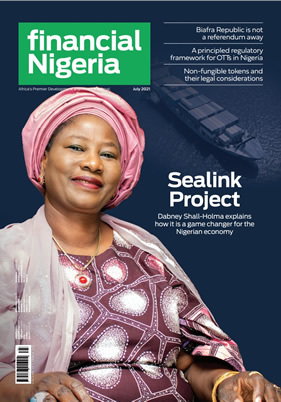
Joy Dimka, Senior Legal Officer, Nigerian Shippers' Council.
Follow Joy Dimka
![]() @JoyDimka
@JoyDimka
Subjects of Interest
- Energy
- International Trade
- Law and Society
How far Nigeria’s maritime has come 12 May 2025
Maritime trade has always been at the heart of Nigeria’s economy – long before the country discovered oil and before its ports were mechanised. Maritime trade, simply put, is the movement of goods and commodities by sea. It involves the use of ships and port infrastructure to transport cargo across international and domestic waterways. As the backbone of global commerce, maritime trade enables countries to exchange goods efficiently and at scale, shaping economies and influencing geopolitical relationships. In Nigeria, with its vast coastline and strategic position along the Gulf of Guinea, maritime trade has long served as a gateway to economic growth, regional integration, and international connectivity.
Maritime trade began to develop in Nigeria after the inglorious slave trade era. By the 1830s when the second wave of the European explorers poured into the West African hinterland to verify the flow of the Niger and to make geographical surveys, the essential ramparts of maritime trade such as wharves, ports, and jetties were already established. The onset of liner services to West Africa, kick-started by Elder Dempster and Woerman Linie in the 1850s, resulted in the gradual development of skeletal port and lighterage facilities.
The need by colonial authorities for passenger shipping services for expatriate colonial workers and the carriage of mails and administrative materials further intensified the speed of development of ports and jetties across West Africa. From 1913, the colonial administrators embarked on basic port infrastructural facilities and railways deemed essential for the crucial transportation of agricultural produce and raw materials to the metropolis.
Long before colonial influences, maritime trade in what is now Nigeria thrived through well-established inland and coastal trade networks. The Niger River, often referred to as the "artery of commerce," served as a major trade route connecting inland regions with coastal ports. Communities along the Bonny, Calabar, and Lagos coasts engaged in active seaborne commerce, exchanging goods such as palm oil, fish, textiles, and salt.
These trade routes were not merely economic channels but cultural bridges, linking local communities to North African and European merchants as early as the 15th century. Indigenous groups, particularly the Ijaw, Itsekiri, and Efik, were deeply involved in fishing and maritime commerce, leveraging their proximity to navigable waters. Their canoes, built for both riverine and coastal travel, were instrumental in transporting goods between hinterland markets and port towns. These early maritime systems laid the groundwork for Nigeria’s integration into the global shipping and trading ecosystem.
With the arrival of European powers, particularly the Portuguese and later the British, these organic systems began to change. Initially, foreign traders paid customs duties directly to local rulers in whose territories they operated. Notably, King Akintoye and Kosoko of Lagos implemented structured customs systems, collecting 3% on imports and 2% on exports through organised agents stationed at the wharves. Similarly, various Yoruba kingdoms operated toll systems that governed trade across their borders, reinforcing indigenous regulatory systems.
The British annexation of Lagos in 1861 marked a significant shift from decentralised native systems to a formalised colonial structure. That year, the British colonial government established the first centralised Customs Department, appointing J.H. Glover as Harbour Master and Collector of Customs. This institution became a cornerstone for British control over maritime trade, combining port oversight with customs regulation and taxation. Worthy of note is the fact that Nigeria, like many African countries, inherited customs systems and laws from colonial administrations, which prioritised control and revenue collection over trade facilitation, and they were never modernised in line with evolving global maritime trade practices.
As colonial administrative structures evolved, so too did Nigeria's maritime infrastructure. The 10-Year Plan for Development and Welfare (1946–1956) catalysed investment in ports, culminating in the creation of the Nigerian Ports Authority (NPA) in 1955 under the Ports Act. The NPA streamlined port services, bringing operations like cargo handling, dredging, and maintenance under one agency. This move helped to centralise control over previously fragmented colonial operations run by the Marine Department, Nigerian Railway, and Public Works Department.
The transformation of Nigeria’s maritime sector during this period reflects a layered history – beginning with indigenous trade practices and evolving through colonial-era reforms that laid the institutional foundations for the modern maritime economy.
The Nigerian Civil War (1967–1970) and the ensuing Cement Armada crisis of the mid-1970s collectively marked a critical juncture in the trajectory of the country’s maritime and port development. While the civil war disrupted existing maritime trade routes and led to the closure and nationalisation of several key ports, the postwar period unleashed a surge in importation – culminating in the infamous Cement Armada – i.e. a surge in cement importation, which overwhelmed the nation's maritime infrastructure. The war had exposed the vulnerability of Nigeria’s ports to regional conflict, while the armada exposed the systemic inefficiencies and administrative lapses in port operations, shipping logistics, and contract management.
The aftermath of the war saw a country in urgent need of reconstruction. However, the federal government’s massive importation of goods – particularly cement, which was essential for rebuilding infrastructure and military installations – far exceeded the capacity of existing port facilities. The Lagos Port Complex, which bore the brunt of these ship arrivals, became a symbol of logistical chaos. At the same time, the failure to expand or rehabilitate supporting infrastructure like hinterland roads, railways, and container terminals compounded the congestion. While makeshift emergency measures were enacted, including the appointment of a military port commandant, these were largely reactive and insufficient to create lasting efficiency.
The lessons from these back-to-back crises began to underscore the necessity for a more decentralised port system and a modernised regulatory and operational framework capable of absorbing international cargo flows. The burden placed on Lagos sparked discussions about diversifying port activity to other coastal locations and investing in long-neglected inland water transport networks. Simultaneously, it prompted a rethinking of Nigeria’s maritime policy posture in both commercial and security terms. International stakeholders – many of whom had been affected by the demurrage payments and delivery delays during the cement saga – also began to view Nigeria’s maritime sector with increased caution.
These developments gradually gave rise to institutional reforms and port expansion projects, setting the stage for further involvement of the private sector and foreign investment in port operations. However, even as these measures gained momentum, the legacy of the civil war and the cement armada lingered as cautionary tales about the perils of uncoordinated national logistics planning, opaque procurement processes, and the neglect of maritime infrastructure within a rapidly growing economy.
In 2003, Nigeria’s seaports were among the least efficient in the world due to inadequate infrastructure, corruption, and procedural entanglements caused by dozens of government agencies competing for slices of the ports’ revenue. Businesses suffered, investors stayed away, and shippers diverted their loads to ports in neighbouring countries. Seeking to improve efficiency, ease the financial burden of administering the ports, and reduce corruption throughout the sector, President Olusegun Obasanjo invited private companies to manage Nigeria’s port terminals in exchange for commitments to invest in port infrastructure and to remit a share of profits and other fees.
The ambitious reform was not easy. Opposition from Nigeria’s legislature nearly derailed the changeover, and acrimonious negotiations with labour unions threatened to prevent the smooth transfer of managerial responsibilities to private operators. Irene Chigbue, head of Nigeria’s privatization bureau, relied on a transparent and closely monitored concession process, political support from the presidency, and controversial legal arguments to achieve her goal.
Finally, in 2006, private terminal operators brought substantial new investments and improved port operations, though complementary reforms were needed in customs and in the government’s regulatory functions to enable Nigerian businesses to realize the full benefits of the new system.
Along with this turn of events came the reform of the Nigerian Maritime Administration and Safety Agency positioned primarily to ensure the compliance with international maritime conventions, promote the development of the shipping industry, and enhance maritime safety and security. In the process of bringing light to these developments, we cannot leave out the development of containerisation, automation, and intermodal connectivity, which is an area that is still developing. We have also witnessed shifts towards ship recycling, fisheries management, coastal tourism, marine biotechnology, and the likes.
Regardless, Nigeria failed to establish a strong regulatory framework to manage competition within the newly liberalised maritime sector. This oversight has had significant implications for the growth and sustainability of the industry. In the absence of a dedicated competition regime, dominant terminal operators and shipping companies were able to consolidate power, often at the expense of smaller players and the wider business community. Without mechanisms to regulate pricing, market behaviour, or service delivery, these operators have enjoyed disproportionate influence over logistics, charges, and access to infrastructure.
However, despite numerous reforms and decades of development, several longstanding issues continue to plague Nigeria's maritime and port sectors, particularly in the areas of infrastructure, policy, and security. Chief among these persistent challenges is the congestion and inefficiency at major seaports such as the Apapa and Tin Can Island ports in Lagos. These ports, which handle the bulk of Nigeria’s imports, often experience crippling delays due to limited berthing space, outdated cargo-handling equipment, and sluggish customs clearance procedures. The congestion is further exacerbated by poor access roads and the absence of an effective truck call-up system, leading to long queues, extortion, and inflated logistics costs.
Another enduring weakness is the lack of functional intermodal transport infrastructure. Nigeria has yet to fully integrate its road, rail, and inland waterway systems into a coherent logistics framework. The result is an overreliance on road transport for cargo evacuation, which not only strains already-deteriorating highways but also inflates the cost of doing business for importers and exporters. Rail connections to ports remain limited and underutilised, while the inland waterways – once envisioned as vital arteries for internal cargo movement – remain largely neglected, suffering from siltation, poor dredging, and inadequate navigation aids.
Policy inconsistency and bureaucratic inertia further compound these physical limitations. Successive administrations have launched reform agendas, but many fail to be implemented effectively or are reversed with changes in leadership. Agencies often work at cross-purposes, with overlapping mandates and regulatory red tape creating a frustrating environment for private investors and operators. The lack of a single-window system for port operations means multiple checkpoints, duplicated inspections, and prolonged vessel turnaround times.
Security concerns also remain a major issue. While Nigeria has made notable progress in curbing piracy in the Gulf of Guinea – thanks to initiatives like the Deep Blue Project led by NIMASA and the Nigerian Navy – sporadic incidents still occur, and the broader region continues to be viewed as a high-risk zone by international insurers. Domestically, port security challenges persist, including theft, vandalism, and unauthorised access to sensitive facilities.
Lastly, the inland water transport system and river ports – such as those in Onitsha, Baro, Lokoja, and Oguta – are severely underutilised. Despite their potential to decongest the seaports and facilitate trade in the hinterlands, these facilities lack consistent dredging, reliable connectivity, and commercial viability due to poor investment and oversight.
In essence, while Nigeria has taken commendable steps toward reforming its maritime and port systems, these deeply rooted issues continue to hamper the sector’s ability to reach its full potential as a driver of economic growth and regional trade leadership. The question remains, in a nutshell, what needs to be done to forge ahead?
Strengthen Maritime Legal and Policy Framework: The absence of a comprehensive and operational national maritime policy has left the sector without clear direction. Although the Federal Ministry of Marine and Blue Economy finalised the draft National Policy on Marine and Blue Economy in December 2024, its implementation remains pending . This policy is crucial for providing a cohesive framework that aligns with international conventions and addresses Nigeria’s specific maritime needs.
Invest in Human Capital and Indigenous Participation: Revitalising maritime training institutions and promoting indigenous shipping companies are essential for building a competent workforce and enhancing local participation. Investing in education and capacity-building initiatives will empower Nigerians to take on key roles within the maritime industry, fostering economic growth and reducing reliance on foreign expertise.
Improve Infrastructure and Digitalisation: Modernising port infrastructure and integrating digital technologies are vital for improving efficiency. The inauguration of the $1.5 billion Lekki Deep Sea Port in Lagos, capable of handling 2.5 million containers annually, is a significant step forward. However, without adequate road and rail connectivity, the benefits of such investments may not be fully realised. Implementing digital solutions like blockchain for cargo tracking can also enhance transparency and reduce corruption.
Enhance Blue Economy Strategy: Developing a clear framework for sustainable ocean resource utilisation is imperative. Encouraging private investment in sectors such as shipbuilding, aquaculture, and marine research can diversify the economy and create employment opportunities. Aligning these initiatives with global best practices will ensure long-term sustainability and environmental stewardship.
Strengthen Security and Transparency: While initiatives like the Deep Blue Project have improved maritime security, ongoing efforts are needed to address piracy and other threats. Leveraging technology such as establishing and completing the Maritime Window Project can further enhance safety while surveillance and the implementation of transparent processes could build investor confidence in the industry.
Conclusion
Nigeria's maritime sector stands at a crossroads. With strategic reforms and investments, it has the potential to become a cornerstone of national development and a leader in the global maritime industry. Stakeholders across government, private sector, and civil society must collaborate to implement the necessary changes, ensuring that Nigeria's maritime domain contributes significantly to economic prosperity and sustainable development.
Joy Dimka is a Senior Legal Officer at the Nigerian Shippers' Council.





